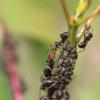1. Location (on a map) of collection: Houston, TX, USA and surrounding area
2. Date of collection: Late June through 2nd week of July, 2019
3. Habitat of collection: In void spaces behind brick fascia on our exterior wall, in empty space between flower pot and drip dish (not directly in the soil though)
4. Length (from head to gaster): Approx 4mm, some workers slightly smaller but seemingly always between 3 and 4mm
5. Color, hue, pattern and texture: Black gaster with lighter bands near the stinger apparent in some photos, red body with slightly darker head
6. Distinguishing characteristics: Double petiole
7. Distinguishing behavior: Super chill ant. At first I thought this might be a carpenter instead of a fire ant since they don't seem to care about being disturbed. I've let them crawl along my hand and they don't bite or sting. Double petiole and small size makes me think it's definitely not a carpenter though.
8. Nest description: I've only found clusters of workers and brood together in small spaces relatively free of soil. There appears to be an established nest in one of our exterior walls.
9. Nuptial flight time and date: I've found what I assume are winged males which are about 5mm long, very similar in appearance to the workers except they have white (clear) wings and developed thorax for flight. I don't believe I've spotted a queen yet.
Imgur link for pictures: https://imgur.com/gallery/YBJkjo5
Hiya! I'm mostly interested in getting a proper ID for this ant because I've seen quite a few of them around our exterior walls and they also seem like nice docile ants for a formicarium. I've spotted these ants along with little black ants and Mexican twig ants. For the most part, all of these ants ignore each other although I've seen the little black ant and one of these ants appear to sort of fight. After a very brief encounter, the larger red and black ant looked like they were rolling around and curled up, acting kind of crazy. The ants in the photos establish trails and they're relatively slow moving (compared to the twig ants for sure).
Any help in getting a positive ID would be greatly appreciated. If I need to directly upload the photos here I'll figure out a way to do so, thanks!















